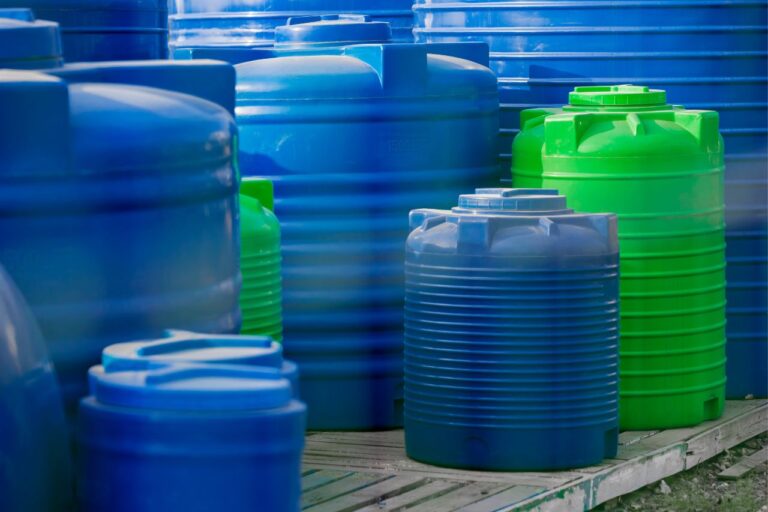The Importance of a Well Water Sediment Tank for Clean Water
Concerned about water quality?
Ensure your family’s safety with a well water sediment tank.
In a world with increasing pollutants, a reliable filtration system is crucial.
This tank removes sediments and impurities, preventing clogged pipes and health risks.
Read the article to discover the benefits of investing in a sediment tank for clean, pure water.
Protect your loved ones now!
How Sediment Tanks Work to Remove Impurities
A well water sediment tank works by using a combination of physical and mechanical processes to remove impurities from the water.
The tank is usually installed at the point where the water enters your home, ensuring that all the water that flows through your plumbing system is filtered.
The sediment tank is designed to capture and trap sediments and other particles that are present in the water supply.
As the water passes through the tank, the sediment settles at the bottom, while the clean water continues to flow through the system.
The sediment can then be periodically flushed out of the tank, ensuring that it does not accumulate and cause any blockages.
This simple yet effective mechanism ensures that the water you consume is free from sediments, debris, and other impurities.
Common Contaminants Found in Well Water
Well water is often considered to be cleaner and more natural than water from other sources.
However, it is still susceptible to various contaminants that can affect its quality.
Some of the common contaminants found in well water include bacteria, viruses, heavy metals, pesticides, and industrial pollutants.
These contaminants can enter the water supply through various means, such as agricultural runoff, industrial waste, and underground seepage.
The presence of these contaminants can not only affect the taste and smell of the water but also pose serious health risks.
A well water sediment tank can help to remove these contaminants, ensuring that the water you consume is safe and healthy.
Benefits of Using a Well Water Sediment Tank
Investing in a well water sediment tank offers numerous benefits for homeowners who value clean and pure water.
Here are some of the key advantages of using a sediment tank:
Improved Water Quality: A sediment tank effectively removes sediments, debris, and other particles from the water, improving its quality and taste.
This means that you and your family can enjoy clean and refreshing water straight from the tap.
Prevents Clogged Pipes: Sediments and other particles can accumulate in your plumbing system over time, leading to clogged pipes and reduced water flow.
By using a sediment tank, you can prevent these issues and ensure that your plumbing system functions optimally.
Extends the Lifespan of Appliances: Sediments and other impurities can cause damage to your appliances, such as water heaters, dishwashers, and washing machines.
By removing these impurities with a sediment tank, you can extend the lifespan of your appliances and save on repair and replacement costs.
Reduces Maintenance and Repair Costs: Sediments can cause damage to plumbing fixtures, leading to costly repairs.
By installing a sediment tank, you can reduce the frequency of maintenance and repair, saving you both time and money in the long run.
Protects Your Health: Contaminated water can pose serious health risks, especially for vulnerable individuals such as children and the elderly.
A well water sediment tank helps to remove harmful contaminants, ensuring that the water you consume is safe for drinking and cooking.
Environmentally Friendly: By investing in a sediment tank, you are reducing your reliance on bottled water, which contributes to plastic waste.
This environmentally friendly choice helps to reduce your carbon footprint and protect the planet.
Factors to Consider When Choosing a Sediment Tank
When choosing a well water sediment tank, there are several factors that you should consider to ensure that you select the right one for your needs.
These factors include:
Size: The size of the sediment tank should be appropriate for the water flow rate in your home.
It should be able to handle the volume of water that you use on a daily basis without compromising its efficiency.
Filtration Capacity: The filtration capacity of the sediment tank determines how effectively it can remove impurities from the water.
Look for a tank that offers a high filtration capacity to ensure that it can effectively remove sediments and other particles.
Installation: Consider the ease of installation when choosing a sediment tank. Some tanks require professional installation, while others can be easily installed by homeowners.
Choose a tank that suits your level of expertise and installation requirements.
Maintenance: Find out about the maintenance requirements of the sediment tank before making a purchase.
Some tanks require regular cleaning and filter replacement, while others are low maintenance.
Consider your willingness and ability to perform maintenance tasks when selecting a sediment tank.
Cost: Cost is an important factor to consider when choosing a sediment tank.
Compare the prices of different tanks and consider the long-term costs associated with maintenance and filter replacement.
Remember that investing in a high-quality tank is a wise choice, as it will ensure that you get the most value for your money.
Brand Reputation: Look for reputable brands that have a track record of producing high-quality sediment tanks.
Read customer reviews and testimonials to get an idea of the performance and reliability of the tank before making a purchase.
Installation and Maintenance of a Sediment Tank
Installing a well water sediment tank is a relatively straightforward process that can be done by a professional or a knowledgeable homeowner.
Here are the general steps involved in installing a sediment tank:
Select the Location: Choose a suitable location for the sediment tank, preferably near the point where the water enters your home.
Ensure that there is enough space for the tank and easy access for maintenance and filter replacement.
Prepare the Plumbing: Shut off the water supply and drain any remaining water from the plumbing system.
Install the necessary fittings, such as valves and connectors, to connect the sediment tank to your plumbing system.
Install the Sediment Tank: Follow the manufacturer’s instructions to install the sediment tank in the chosen location.
Connect the inlet and outlet pipes to the tank, ensuring a secure and leak-free connection.
Flush the Tank: Before using the sediment tank, flush it with water to remove any loose debris or particles that may be present.
This will ensure that the tank is clean and ready to effectively filter the water.
Regular Maintenance: Follow the recommended maintenance schedule provided by the manufacturer.
This may include periodically flushing the tank, cleaning the filter, and replacing any worn-out parts.
Regular maintenance will ensure that the sediment tank continues to function optimally and provide clean and pure water.
Additional Water Treatment Options for Well Water
While a well water sediment tank is a crucial component of any water treatment system, there are additional options available to further enhance the quality of your well water.
These options include:
Water Softeners: If your well water is hard, meaning it contains high levels of minerals such as calcium and magnesium, a water softener can help to remove these minerals.
Water softeners use ion exchange technology to replace the minerals with sodium or potassium, resulting in softer water.
UV Disinfection Systems: If your well water is contaminated with bacteria, viruses, or other microorganisms, a UV disinfection system can be used to kill these pathogens.
UV light is highly effective in destroying microorganisms, ensuring that your water is safe for consumption.
Activated Carbon Filters: Activated carbon filters are excellent for removing chlorine, volatile organic compounds (VOCs), and other chemicals that may be present in well water.
These filters work by adsorption, where the contaminants adhere to the surface of the carbon filter.
Reverse Osmosis Systems: For comprehensive water purification, a reverse osmosis system can be installed.
These systems use a semi-permeable membrane to remove a wide range of contaminants, including sediments, bacteria, viruses, heavy metals, and chemicals.
Case Studies and Success Stories
To further illustrate the benefits of using a well water sediment tank, let’s explore some case studies and success stories from homeowners who have invested in this essential water treatment system.
Case Study 1: John and Sarah
John and Sarah live in a rural area and rely on a well for their water supply.
They noticed that their water had a strong odor and was discolored, leading to concerns about its quality.
After installing a well water sediment tank, they immediately noticed a significant improvement in the color and smell of their water.
The sediment tank effectively removed the sediments and other impurities, providing them with clean and pure water.
John and Sarah no longer worry about the health risks associated with contaminated water and are delighted with their decision to invest in a sediment tank.
Case Study 2: Lisa
Lisa recently moved into an older home with a well water system.
She quickly realized that the plumbing was frequently clogged, and the water flow was inconsistent.
After consulting with a water treatment specialist, she decided to install a well water sediment tank.
The sediment tank resolved the plumbing issues by effectively removing the sediments and particles that were causing blockages.
Lisa is now enjoying improved water flow and has peace of mind knowing that her water is free from impurities.
Case Study 3: Mark and Emily
Mark and Emily have a young child and were concerned about the quality of their well water, particularly the presence of bacteria and viruses.
They decided to install a well water sediment tank along with a UV disinfection system to ensure that their water was safe for their child to drink.
The combination of the sediment tank and UV disinfection system provided them with the peace of mind they were looking for.
Mark and Emily are confident that their child is drinking clean and pure water, free from harmful contaminants.
Conclusion: Investing in a Well Water Sediment Tank for Clean and Pure Water
In conclusion, a well water sediment tank is an essential investment for homeowners who prioritize clean and pure water.
With the increasing levels of pollution and contaminants in our environment, it is crucial to have a reliable filtration system in place.
A sediment tank effectively removes sediments, debris, and other impurities from the water supply, ensuring that you and your family can enjoy clean and refreshing water straight from the tap.
By investing in a well water sediment tank, you can say goodbye to clogged pipes, foul-smelling water, and the potential health risks associated with contaminated water.
Remember to consider factors such as size, filtration capacity, installation, maintenance, and cost when choosing a sediment tank.
Additionally, explore additional water treatment options such as water softeners, UV disinfection systems, activated carbon filters, and reverse osmosis systems to further enhance the quality of your well water.
Take inspiration from case studies and success stories to see how a well water sediment tank has transformed the lives of homeowners.
Make the wise choice today and invest in a well water sediment tank for clean and pure water.



